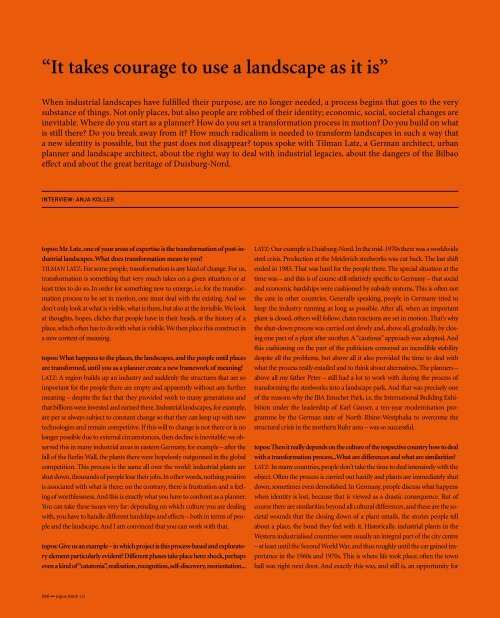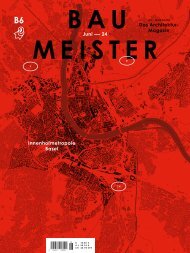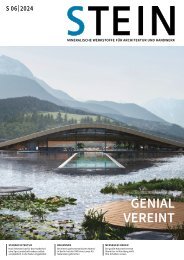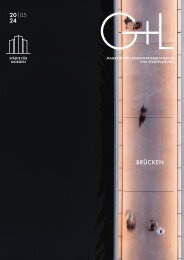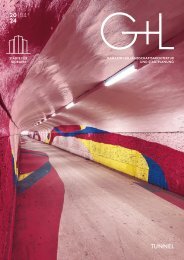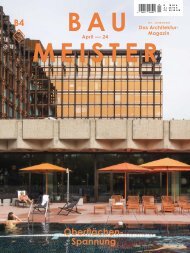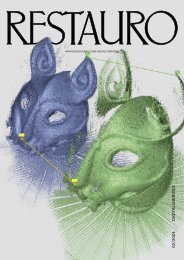topos113
uban mutation
uban mutation
Sie wollen auch ein ePaper? Erhöhen Sie die Reichweite Ihrer Titel.
YUMPU macht aus Druck-PDFs automatisch weboptimierte ePaper, die Google liebt.
“It takes courage to use a landscape as it is”<br />
When industrial landscapes have fulfilled their purpose, are no longer needed, a process begins that goes to the very<br />
substance of things. Not only places, but also people are robbed of their identity; economic, social, societal changes are<br />
inevitable. Where do you start as a planner? How do you set a transformation process in motion? Do you build on what<br />
is still there? Do you break away from it? How much radicalism is needed to transform landscapes in such a way that<br />
a new identity is possible, but the past does not disappear? topos spoke with Tilman Latz, a German architect, urban<br />
planner and landscape architect, about the right way to deal with industrial legacies, about the dangers of the Bilbao<br />
effect and about the great heritage of Duisburg-Nord.<br />
INTERVIEW: ANJA KOLLER<br />
topos: Mr. Latz, one of your areas of expertise is the transformation of post-industrial<br />
landscapes. What does transformation mean to you?<br />
TILMAN LATZ: For some people, transformation is any kind of change. For us,<br />
transformation is something that very much takes on a given situation or at<br />
least tries to do so. In order for something new to emerge, i.e. for the transformation<br />
process to be set in motion, one must deal with the existing. And we<br />
don't only look at what is visible, what is there, but also at the invisible. We look<br />
at thoughts, hopes, clichés that people have in their heads, at the history of a<br />
place, which often has to do with what is visible. We then place this construct in<br />
a new context of meaning.<br />
topos: What happens to the places, the landscapes, and the people until places<br />
are transformed, until you as a planner create a new framework of meaning?<br />
LATZ: A region builds up an industry and suddenly the structures that are so<br />
important for the people there are empty and apparently without any further<br />
meaning – despite the fact that they provided work to many generations and<br />
that billions were invested and earned there. Industrial landscapes, for example,<br />
are per se always subject to constant change so that they can keep up with new<br />
technologies and remain competitive. If this will to change is not there or is no<br />
longer possible due to external circumstances, then decline is inevitable: we observed<br />
this in many industrial areas in eastern Germany, for example – after the<br />
fall of the Berlin Wall, the plants there were hopelessly outgunned in the global<br />
competition. This process is the same all over the world: industrial plants are<br />
shut down, thousands of people lose their jobs. In other words, nothing positive<br />
is associated with what is there; on the contrary, there is frustration and a feeling<br />
of worthlessness. And this is exactly what you have to confront as a planner.<br />
You can take these issues very far: depending on which culture you are dealing<br />
with, you have to handle different hardships and effects – both in terms of people<br />
and the landscape. And I am convinced that you can work with that.<br />
topos: Give us an example – in which project is this process-based and exploratory<br />
element particularly evident? Different phases take place here: shock, perhaps<br />
even a kind of “catatonia”, realisation, recognition, self-discovery, reorientation...<br />
LATZ: Our example is Duisburg-Nord. In the mid-1970s there was a worldwide<br />
steel crisis. Production at the Meiderich steelworks was cut back. The last shift<br />
ended in 1985. That was hard for the people there. The special situation at the<br />
time was – and this is of course still relatively specific to Germany – that social<br />
and economic hardships were cushioned by subsidy systems. This is often not<br />
the case in other countries. Generally speaking, people in Germany tried to<br />
keep the industry running as long as possible. After all, when an important<br />
plant is closed, others will follow; chain reactions are set in motion. That’s why<br />
the shut-down process was carried out slowly and, above all, gradually, by closing<br />
one part of a plant after another. A “cautious” approach was adopted. And<br />
this cushioning on the part of the politicians conveyed an incredible stability<br />
despite all the problems, but above all it also provided the time to deal with<br />
what the process really entailed and to think about alternatives. The planners –<br />
above all my father Peter – still had a lot to work with during the process of<br />
transforming the steelworks into a landscape park. And that was precisely one<br />
of the reasons why the IBA Emscher Park, i.e. the International Building Exhibition<br />
under the leadership of Karl Ganser, a ten-year modernisation programme<br />
by the German state of North Rhine-Westphalia to overcome the<br />
structural crisis in the northern Ruhr area – was so successful.<br />
topos: Then it really depends on the culture of the respective country how to deal<br />
with a transformation process...What are differences and what are similarities?<br />
LATZ: In many countries, people don't take the time to deal intensively with the<br />
object. Often the process is carried out hastily and plants are immediately shut<br />
down, sometimes even demolished. In Germany, people discuss what happens<br />
when identity is lost, because that is viewed as a drastic consequence. But of<br />
course there are similarities beyond all cultural differences, and these are the societal<br />
wounds that the closing down of a plant entails, the stories people tell<br />
about a place, the bond they feel with it. Historically, industrial plants in the<br />
Western industrialised countries were usually an integral part of the city centre<br />
– at least until the Second World War, and thus roughly until the car gained importance<br />
in the 1960s and 1970s. This is where life took place; often the town<br />
hall was right next door. And exactly this was, and still is, an opportunity for<br />
086 topos ISSUE 113


